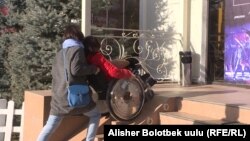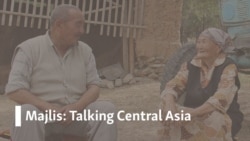Having a good neighbor in a tough part of the world is a real plus.
That is especially true now for countries sharing land borders during the coronavirus pandemic.
During this global crisis, a country's best efforts to curb the spread of the coronavirus can be damaged and even undone by the irresponsible actions or policies of a contiguous neighbor.
Central Asia lies at the heart of the Eurasian continent and land borders are the norm except for the Caspian Sea coasts belonging to Kazakhstan and Turkmenistan.
The history of Central Asia's borders since Kazakhstan, Kyrgyzstan, Tajikistan, Turkmenistan, and Uzbekistan became independent following the 1991 collapse of the Soviet Union is largely one of tensions.
The five inherited their tangled borders from the Soviet Union.
Since that country's disintegration there have been disagreements about those borders and problems with who or what crosses from a neighboring country.
And no Central Asian country needs a border problem added to the many challenges they face now combating the coronavirus pandemic or coping with the accompanying serious economic setbacks it brings.
But two serious border problems occurred in May that resulted in two very different stories about the state of border relations in the region.
Dam Devastation
Uzbekistan's Sardob Reservoir -- completed just four years ago -- burst on May 1, flooding large areas in Syrdarya Province, killing several people and forcing some 70,000 to evacuate.
But it also flooded parts of the Maktaaral district in neighboring Kazakhstan, seriously damaging 10 towns and forcing the evacuation of some 5,000 people.
Kazakh authorities complained that Uzbek officials were slow and inaccurate in warning Kazakhstan about the coming flood waters.
On May 5, Kazakh Deputy Minister of Ecology, Geology, and Natural Resources Sergei Gromov said his Uzbek counterpart had called to tell him about the burst dam but told him the water was unlikely to reach Kazakhstan.
Gromov mentioned that Kazakhstan had been against the construction of the Sardob Reservoir from the start.
As of May 4, the Turkestan provincial administration in Kazakhstan was preparing a note of protest for Uzbek officials and was considering a claim for financial damages, but the note was apparently never sent.
It seemed Kazakh-Uzbek ties were headed down a bumpy road because of the damage done by the burst dam and if Uzbekistan's first president, Islam Karimov, had still been alive at the time of the flooding, the issue would almost surely have become another sore spot in relations.
But Karimov -- who died in 2016 but often had confrontational relations with Kazakhstan -- was succeeded by his longtime prime minister, Shavkat Mirziyoev.
Mirziyoev has since pursued a much friendlier policy towards Uzbekistan's neighbors.
On May 2, Mirziyoev and Kazakh President Qasym-Zhomart Toqaev spoke by phone about the flooding with Mirziyoev apologizing for the incident and promising to help the Kazakh residents who suffered damages.
On May 10, Uzbek Prime Minister Abdullo Aripov went to the Maktaaral district where he met with his Kazakh counterpart, Askar Mamin.
Aripov and Mamin toured four of the towns damaged by the flood and posed for a photo holding shovels of cement at a construction site in the town of Myrzakent.
Reports from Kazakh and Uzbek news websites noted that Uzbekistan sent more than 200 "specialists" along with emergency vehicles, bulldozers, tractors, water pumps, and other equipment to help clean up and rebuild the damaged towns.
Such an outcome would have been unimaginable under Karimov and the current cooperation despite the devastation along the border is a positive development for the region.
Border Clashes Yet Again
Along the Kyrgyz-Tajik border it was a very different story, though unfortunately a very familiar one in recent years.
Only 519 kilometers of the approximately 970 kilometers of border between Kyrgyzstan and Tajikistan have been demarcated and in many of the areas where the border is unclear, fighting sporadically breaks out between Kyrgyz and Tajik villagers.
Such conflicts have increased in frequency in the past 10 years.
Cars have been damaged, buildings burned, orchards destroyed, crops trampled upon, and many people injured by sticks or stones and -- unfortunately in some cases -- by gunshots.
On May 8, clashes broke out again not far from the Kyrgyz village of Chek.
It was an all-too-typical story: someone doing something on land that other people think belongs to them.
In this case, one young Kyrgyz man lost his home to fire and Tajik border guards say two villagers on their side of the border received gunshot wounds.
Kyrgyz border guards, for their part, say a Kyrgyz villager was hospitalized after being hit by rocks thrown at him, and three Kyrgyz border guards were injured by mortar fire from Tajikistan.
The two countries have exchanged protest notes and once again representatives from the two countries met, agreeing to do everything possible to decrease tensions along the border, something they have agreed to do many times before.
But the Kyrgyz-Tajik border has become the most dangerous one in Central Asia, a dubious distinction that once belonged to the Kyrgyz and Tajik borders with Uzbekistan when Karimov was president.
Not only were trespassers on Uzbek territory likely to be shot, the Uzbek military also placed land mines along parts of its mountainous frontiers with Kyrgyzstan and Tajikistan.
The land mines have since been removed, Uzbek border guards are not as trigger-happy as they once were, and Kyrgyz and Tajik relations with Uzbekistan have arguably never been better than they are now with Mirziyoev.
Even a meeting between Kyrgyz President Sooronbai Jeenbekov and Tajik President Emomali Rahmon on the border in late July 2019 did little to resolve the long-festering frontier problems.
One Tajik citizen was killed in a clash just before that meeting, and three Tajik border guards and one Kyrgyz border guard were killed in fighting in September. Another Kyrgyz serviceman was shot and wounded in December, and already in January of this year fighting also broke out.
The mortar rounds that exploded in Kyrgyzstan on May 8 are not the first to be fired from Tajikistan.
In January 2014, there were clashes in the same area and Kyrgyz border guards said their Tajik counterparts used mortars and grenade launchers. Five Kyrgyz border guards and two Tajik border guards were wounded in that skirmish.
The clash in January 2020 led to talk about a land swap, but in a sign of how intractable some people are on both sides, some villagers vowed not to give up one square centimeter of "their" territory.
The Kyrgyz-Tajik border area is far from the countries' capital cities, Bishkek and Dushanbe, and both governments have not worked as hard as they could to resolve this longstanding problem, leaving it up to local officials to practice damage control after every new violent incident.
The very different stories from the borders of Central Asia feature the two wealthiest countries in the region working to cultivate better ties despite the obstacles and the two poorest countries failing to improve relations that continue to fissure.












